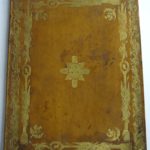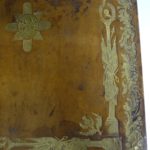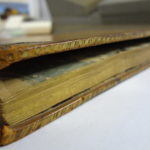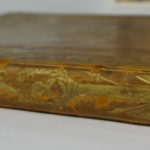52 Weeks of Fantastic Bindings: Week 9
An unrecorded James Scott of Edinburgh binding
A recently catalogued volume of three of Robert Colvill’s (d. 1788) poems stood out from the tedium of commercial 18th century bindings found in the last portion of the Typ-Edinburgh collection. This volume, purchased in 1956, proved to be a bit of a mystery at first: although the tooling and decorations were stunning, the binding was not signed. TypBE.D79XC is bound in contemporary calf on boards, with a gold rolled floral border, within which are gold stamped columns with thistles stamped in gold at each corner and with the star of the Order of the Thistle stamped in gold on both boards, with a gold stamped column and flower on spine, it also has distinct gold tooled board edges.
- Front cover of TypBE.D79XC, a collection of three of Robert Colvill’s poems, bound by James Scott of Edinburgh, c. 1780.
- Detail of the distinct column tool linked to James Scott of Edinburgh, with the star of the Order of the Thistle at top left.
- Detail of the board edges of TypBE.D79XC, a unique design used by James Scott of Edinburgh.
- The spine of TypBE.D79XC, with James Scott’s distinct column tool stamped in gold.
A bookseller’s note on the front free endpaper was the only clue to a possible identity of the binder responsible for this work : ”? Scott of Edinburgh Binding?” After tracing down James and William Scott in the Scottish Book Trade Index, and the National Library of Scotland’s page on decorative bookbindings, I had a look into J. H. Loudon’s James Scott and William Scott, bookbinders (Ilkey: Scolar Press, 1980). This fantastic, and thorough work was most helpful in identifying the column tools (Loudon, ArI. 5) and board edge decoration (Loudon, RoI. 27) and confirmed that this was, indeed, a James Scott binding, circa 1780. James Scott was a bookbinder operating in Edinburgh between 1773-1792 and was known by many contemporaries as a highly skilled craftsman, working for the Society of Antiquaries of Scotland, The Faculty of Advocates and Newbattle Abbey.
This volume was not included in Loudon’s survey (probably because this volume was uncatalogued and unknown), and is very distinct in its use of the column architectural tool on the boards and spine as well as the star of the Order of the Thistle. No other Scott book recorded by Loudon has an Order of the Thistle connection. Also of note, the floral roll-stamp used for the border is similar to some of the rolls that Loudon lists (RoI. 13 & 25) but not exaclty the same, and the thistle used in the corners had no match as well.
Loudon describes the work of James Scott as “rising like a landmark in the anonymous plain of eighteenth-century Scottish bookbinding …” and after working through almost a thousand items of 17th and 18th century bindings in the past 6 months I can absolutely agree. It is rare to come across such a fine Scottish binding in a late-18th century collection, and it is a delight to have found this one in ours!
–DG



